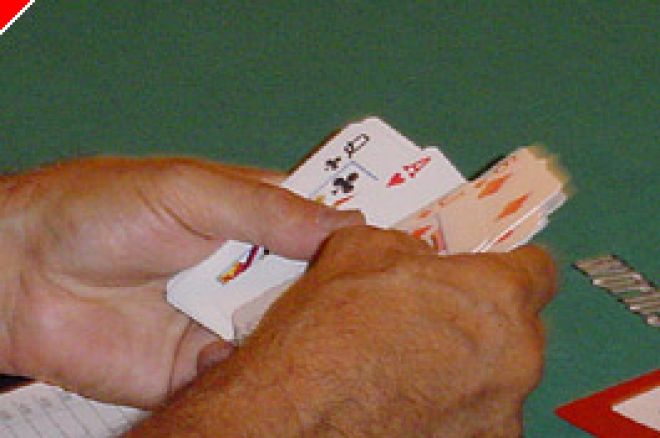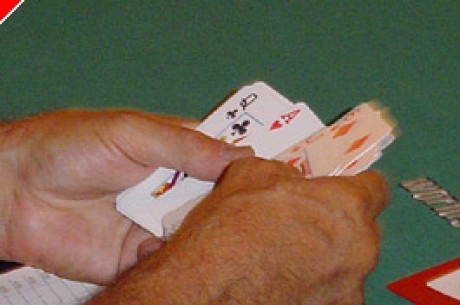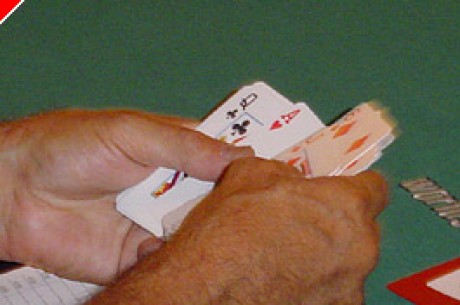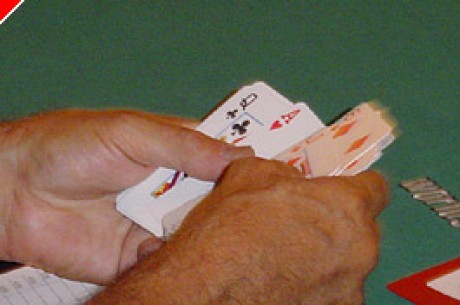Stud Poker Strategy: Fifth Street Defense

Most poker players want to learn how to be aggressive. It's important in this game. Passive play is usually losing play. We don't want to be "calling stations" that call and check and rarely initiate action.
A basic lesson begins with the first three cards - "Third Street". We learn to raise with what we presume to be the highest pair. As we progress we also learn about throwing in the occasion semi-bluff when we have the highest card but not the highest pair - with a hand like (3h-3d)Ah for example.
These are important tools to be sure. You do need to know how to be aggressive at the table during all phases of a stud hand. But defense is also important. While it feels better to bet and raise, it's crucial for the winning player to also know when to fold, call and check. This is especially true in limit stud, as the eventual size of the bet compared with the pot becomes relatively small.
This diminishing bet to pot ratio leads many players to adopt a fatalistic attitude about their hand as it progresses from Third Street to the River. If they call on Third they tend to stay in all the way. Clearly this is an oversimplification. But it does generally characterize a profound problem for many players. They often can't get away from their hands.
For you play profitably, however, you must learn to get away from hands that started out in the lead but that are likely to have fallen behind. A good time to make that second assessment of where your hand is at comes on Fifth Street.
This is a problem even for better players. They know the aggressive tricks of the trade and have used them to knock players out of hands on later streets. And so, when they see other players being aggressive, they often incorrectly presume that their opponent is being similarly tricky - and so they call. Here's an example.
It's Fifth Street. Three players are left in the hand. You have the third hand.
(xx) Ks9c2c
(xx) Jh3h2h
(5cAd)As4c2d
You raised on Third Street, when you were surely in the lead with a pair of Aces. You got called by these three players. On Fourth Street you led again and got called. Now it's Fifth Street. You aren't worried by the first player. He's a calling station who most likely started with a pair on the hole or a pair of Kings and didn't believe your raise meant you had Aces. You see the 3-Flush. You're concerned that he may have made his flush. But you also know he may have started with a pair and may only be drawing to a flush. You don't want to give him a free card. So you decide to bet.
The first player calls your bet. The second player, however, raises. Now what do you do?
If you're a thoughtful and aggressive player you might well conclude that the raiser is bluffing - trying to get you to think he has the flush when he really has a flush draw - hoping to buy himself a free card on Sixth Street by inducing you to check on the next round. It is, after all, highly unlikely that he was dealt five suited cards in succession. So you call his raise.
This is generally a mistake. Here's why.
While it's true that he may be bluffing or, more likely semi-bluffing at this point - not really having the flush he is representing - even if he doesn't have the flush he is probably ahead of you at this moment. In other words, his likely 4-Flush with a lower pair is a favorite to your pair of Aces.
You spotted a likely semi-bluff. But you responded incorrectly, wrongly assuming that if you were correct in your observation that you should call him.
Here's the problem. If you were 100% certain that he had a pair and a 4-Flush you would be correct to call - even as an underdog. I'm not going to give you all of the math now because I'm too lazy, but leave it to say that you are close enough to make chasing correct because of the money in the hand and the third player who is far behind each of you. If he folds or calls, your battle leaves enough money in the pot it to be profitable to chase.
But you can't be 100% certain that he doesn't have the flush. And if he does have one you are a prohibitive underdog - with less than a 5% chance of winning. Combine those two possibilities - that you are a small underdog or that you are a huge underdog - and you have a situation where you should surely fold.
A 3-flush on board on Fifth Street is a huge danger sign. When you see it, even if you think your opponent is bluffing, you should nearly always fold if you only have a pair.
Here's another Fifth Street danger sign - a more obvious one. Three of a kind. Unless you already have it beaten you should surely fold. Even if you hit your hand you could be drawing dead against a full house. Many players draw to flushes and straights or lower trips against exposed bigger trips. This is a huge mistake. You are worse than a 3:1 dog. Recognize the danger sign and get out.
Here's another situation - when you should respect aggression because it probably correctly represents a stronger hand even if it's not obvious.
You started with a Premium Pair. Your good opponent calls after you raise on Third Street. You bet again on Fourth Street when neither of you seem to improve. He calls again. On Fifth Street he catches an Ace and you pair your Fourth Street card - giving you two pair. You are high on board with your pair and bet. Your opponent raises you. Unless he is a maniac you should fold.
Here's a diagram of the hand as it progresses.
(K3)K raise to $20
(xx)9 calls $20
(K3)K8 bets $20
(xx)9Q calls $20
(K3)K88 bets $40
(xx)9QA raises to $80
Your opponent is representing one of two things. Either he has been slow playing trips (9s or Queens) or, more likely) he started with a pair and just hit Aces Up. Either way, you are woefully behind (about a 5:1 dog) and should fold now.
It's tempting to call the raise, believing that you might catch your full house or that your opponent doesn't have you beat at this point but is only bluffing. But you must resist that temptation as wishful thinking.
It's unlikely to the extreme that your opponent would actually be hoping to knock you off of your likely Kings up with a bluff in this situation. Players are unlikely to fold after they have initiated the betting on a round. So bluffing players who do this is unlikely to be successful. Similarly, there isn't a drawing hand that is likely for your opponent in this example - making a semi-bluff unlikely as well. He's most likely to have what he appears to have - which is a hand with much better expectations than yours.
Here's a general rule of thumb that you can use on Fifth Street when you're facing what may well be a superior hand to yours. If the hand that your opponent is representing is better or has a better expectation of winning on the River than your hand and if his draw is better than your draw then you should fold - even if you're not sure if he has the hand that he is representing and even if the pot is already fairly large.
Ed note: Great Stud action at Doyle's Room








